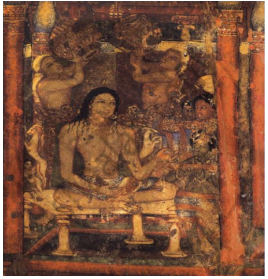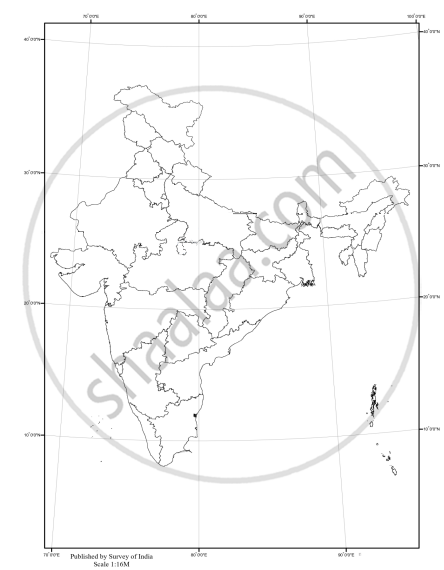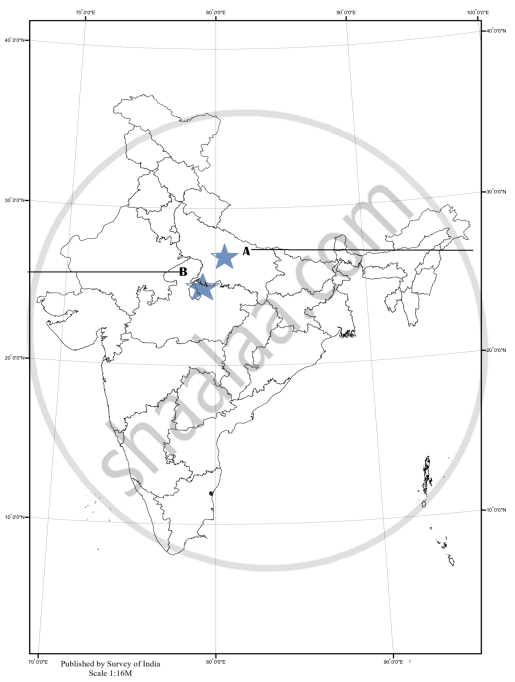Commerce (English Medium)
Science (English Medium)
Arts (English Medium)
Academic Year: 2024-2025
Date: मार्च 2025
Advertisements
General Instructions:
- Question paper comprises five Sections - A, B, C, D and E. There are 34 questions in the question paper. All questions are compulsory.
- Section A - Question 1 to 21 are MCQs of 1 mark each.
- Section B - Question no. 22 to 27 are Short Answer Type Questions, carrying 3 marks each. Answer to each question should not exceed 60-80 words.
- Section C - Question no 28 to 30 are Long Answer Type Questions, carrying 8 marks each. Answer to each question should not exceed 300-350 words.
- Section D - Question no.31 to 33 are Source based questions with three sub questions and are of 4 marks each.
- Section E - Question no. 34 is Map based, carrying 5 marks that includes the identification and location of significant test items. Attach the map with the answer book.
- There is no overall choice in the question paper. However, an internal choice has been provided in few questions. Only one of the choices in such questions have to be attempted.
- In addition to this, separate instructions are given with each section and question, wherever necessary.
Which of the following options accurately describes the significance of the Sangam Age in the context of literature?
It marked the introduction of Sanskrit literature in South India.
It was a period of decline in literary activities in Tamil Nadu.
It witnessed the flourishing collection of ancient Tamil literature.
It was characterized by the dominance of Greek literature in India.
Chapter:
To which one of the following dynasties did Raja Gotami-puta Siri-Satakani belong?
Vakataka
Satvahana
Kushan
Gupta
Chapter:
Assertion (A): Recovering artefacts is merely the initial step in the archaeological process.
Reason (R): Archaeologists employ various methods such as classification based on material and function, analysis of contextual clues, and reliance on indirect evidence to understand the significance and purpose of artefacts.
Both (A) and (R) are correct and (R) is the correct explanation of (A).
Both (A) and (R) are correct, but (R) is not the correct explanation of (A).
(A) is correct, but (R) is not correct.
(R) is correct, but (A) is not correct.
Chapter:
Consider the following statements regarding Buddhism and choose the correct option.
- The concept of Bodhisattva is central to Hinayana sect of Buddhism.
- Bodhisattva is a compassionate one on his way to enlightenment.
- Bodhisattva achieve nibbana for personal salvation.
II and III
II and III
I and II
I and III
Chapter:
Match the column I with column II regarding the archaeologist who worked in the exploration of Indus valley and choose the correct option.
| Column I | Column II | ||
| a | Daya Ram Sahni | i | Authored “Mohenjodaro & the Indus Civilisation” |
| b | Rakhal Das Banerji | ii | Discovered seals at Harappa |
| c | John Marshall | iii | Found seals at Mohenjodaro |
| d | R.E.M. Wheeler | iv | Authored “Ancient India” |
a − iii, b − i, c − ii, d − iv
a − iii, b − iv, c − i, d − ii
a − i, b − ii, c − iii, d − iv
a − ii, b − iii, c − i, d − iv
Chapter:
Identify the ruler of the ancient India with the help of following information:
|
He was a prominent Shaka ruler. He rebuilt Sudarshana Lake in the second century CE. He showcased his engagement with Sanskritic traditions. |
Vikramaditya II
Bhaskaravarman
Bimbisara
Rudradaman
Chapter:
Identify which of the following options refers to the ancient cave painting given below?

Ajanta Cave Paintings
Bagh Cave Paintings
Sittanavasal Cave Paintings
Ellora Cave Paintings
Chapter:
Which of the following skills can be identified from Al-Biruni's writings?
Proficiency in diplomacy and political negotiation.
Fluency in multiple languages and a broad intellectual curiosity.
Expertise in military strategy and warfare tactics.
Exceptional talent for storytelling and vivid descriptions.
Chapter:
Which of the following statements is incorrect about Andal?
Andal was a woman Alvar, the most striking features of her compositions were widely sung.
Andal was a woman Nayanar, she incorporated the prevailing caste system in the society.
Andal saw herself as the beloved of Vishnu; her verses express her love for the deity.
Andal saw herself as the beloved of Krishna; her verses express her love for the deity.
Chapter:
Imagine you are analysing a historical document from the Vijayanagar Empire. Which of the following documents would be most helpful in understanding the relationship between the empire and religious institutions?
A military chronicle detailing the conquests of a Vijayanagar rulers.
A record of diplomatic exchanges with traders and foreign ambassadors.
A legal code outlining the rights and responsibilities of urban classes.
An imperial decree granting land or privileges to a sacred organization.
Chapter:
Match the column I with column II regarding the travellers who visited the Vijayanagar empire and choose the correct option:
| Column I | Column II | ||
| a | Nicolo de Conti | i | Ambassador of Persia visited in the 15th century. |
| b | Abdur Razzaq | ii | Italian trader who visited in the 15th century. |
| c | Afanasii Nikitin | iii | Portuguese traveller who visited in the 16th century. |
| d | Duarte Barbosa | iv | Merchant from Russia who visited in the 15th century. |
a − iii, b − i, c − ii, d − iv
a − iii, b − iv, c − i, d − ii
a − i, b − ii, c − iii, d − iv
a − ii, b − i, c − iv, d − iii
Chapter:
Which of the following developments significantly contributed to the increased flow of silver bullion into India through trade with Europe during the 16th-18th centuries?
The rise of the Ottoman Empire in Asia.
The opening of the new world through voyages.
The Ming Dynasty's expansion into Southeast Asia.
The decline of the Safavid Empire in Asia.
Chapter:
How did the compilation of the Ain-i Akbari contribute to Emperor Akbar's vision of governance? Choose the best suitable option from the following.
By emphasizing military strategies for territorial expansion.
By documenting religious rituals and practices across the empire.
By providing information on administrative and cultural traditions.
By focusing on trade routes and economic policies.
Chapter:
What insights did Francois Bernier provide about the economic structure of Mughal India? Choose the best suitable option from the following.
The prevalence of private land ownership and equitable distribution of wealth.
The dominance of state-controlled resources and limitations on private property.
The absence of trade networks and economic isolation from global markets.
The reliance on foreign investments and the absence of indigenous industries.
Chapter:
Compare and contrast the impacts of the American Civil War on cotton production in India and the United States. Choose the best suitable option from the following.
Both countries experienced a decline in cotton production due to the war.
India's cotton production increased while the United States experienced a decline.
The United States saw increased cotton production while India's remained stagnant.
Both countries saw a surge in cotton exports during the war period.
Chapter:
Advertisements
Why did the rebellion in Awadh become a symbol of resistance against British rule? Choose the best suitable option from the following.
Due to the region's economic prosperity under native rule.
Due to the displacement of Nawab Wajid Ali Shah and taluqdars.
Due to favourable land revenue policies towards the peasantry.
Due to Awadh ‘s central position for organizing rebel forces.
Chapter:
Which of the following represents the correct chronological order of events related to agrarian developments in India during the 19th century?
- The Permanent Settlement in Bengal
- The Deccan Riots Commission
- The Santhal Rebellion
- The Fifth Report by a Select Committee
I, II, III and IV
II, III, IV and I
III, II, I and IV
I, IV, III and II
Chapter:
Which one of the following was Gandhi’s main demand for the peasants in Champaran?
Increase in minimum wages of workers.
Freedom to cultivate the crops of their choice.
Reduction in government taxes for social classes.
Indian education for all farmers' children.
Chapter:
Complete the following with the correct option regarding the role of leaders in the history of nationalism of their respective countries.
Ho Chi Minh: Vietnam, George Washington: ____________
USA
UK
France
Canada
Chapter:
Identify the ruler of India in the 1850s from the given options using the provided information.
|
Nana Sahib
Kunwar Singh
Birjis Qadr
Maulvi Ahmadullah Shah
Chapter:
Which of the following were the key ideals associated with the social struggles in India since the nineteenth century?
Autonomy, hierarchy, and traditionalism
Democracy, equality, and justice
Imperialism, colonialism, and bureaucracy
Monarchy, privilege, and conservatism
Chapter:
Analyse the layout of Harappan cities to identify features that promoted cleanliness and public health.
Chapter:
Examine the challenges historians face in deciphering the Harappan script.
Chapter:
How does the Mahabharata show the multicultural nature of ancient Indian society? Explain with examples.
Chapter:
Examine the impact of Bhakti and Sufi poetry on the development of regional languages and literature.
Chapter:
Examine how music and devotional songs in Bhakti and Sufi traditions serve spiritual expression and community unity.
Chapter:
Explain the term "Little Republics" as applied to villages during the Mughal period.
Chapter:
Describe the aspirations and objectives of the rebels during the Indian Rebellion of 1857, as reflected in their proclamations and actions.
Chapter:
Advertisements
Analyse the rise of the Jotedars and their significance in rural Bengal during the late 18th century.
Chapter:
How did the philosophical and religious developments during the first millennium BCE in India influence the socio-political aspects? Explain with examples.
Chapter:
How did the construction of stupas contribute to the spread of Buddhist teachings? Explain with examples.
Chapter:
'Vijayanagar empire was characterised by a distinctive architecture and building styles.’ Justify the statement.
Chapter:
‘The establishment of the Vijayanagar Empire considered significant in the history of the Indian subcontinent’. Justify the statement.
Chapter:
A How did the Constituent Assembly address the issue of social justice, particularly concerning the rights of the people? Explain.
Chapter:
Explain the distribution of powers between the Centre and the States, as debated in the Constituent Assembly, highlighting differing viewpoints and concerns.
Chapter:
Read the following source carefully and answer the questions that follow:
|
Inscriptions Inscriptions are writings engraved on hard surfaces such as stone, metal, or pottery. They usually record the achievements, activities, or ideas of those who commissioned them and include the exploits of kings or donations made by women and men to religious institutions. Inscriptions are virtually permanent records, some of which carry dates. Others are dated on the basis of palaeography or styles of writing, with a fair amount of precision. For instance, in c. 250 BCE, the letter “a” was written like this: By c. 500 CE, it was written like this: The earliest inscriptions were in Prakrit, a name for languages used by ordinary people. Names of rulers such as Ajatasattu and Asoka, known from Prakrit texts and inscriptions, have been spelt in their Prakrit forms in this chapter. You will also find terms in languages such as Pali, Tamil, and Sanskrit, which too were used to write inscriptions and texts. It is possible that people spoke in other languages as well, even though these were not used for writing. |
- What role does palaeography play in determining the age of inscriptions? (1)
- How do inscriptions contribute to our understanding of ancient societies and cultures? (1)
- What insights can be gained from studying the languages used in inscriptions across different regions and time periods? (2)
Chapter:
Read the following source carefully and answer the questions that follow:
|
Translating texts, sharing ideas Translating texts, sharing ideas Al-Biruni’s expertise in several languages allowed him to compare languages and translate texts. He translated several Sanskrit works, including Patanjali’s work on grammar, into Arabic. For his Brahmana friends, he translated the works of Euclid (a Greek mathematician) into Sanskrit. |
- Analyse the advantage Al-Biruni gained from his expertise in multiple languages? (1)
- Analyse the significance of Al-Biruni translating Patanjali's work on grammar into Arabic? (1)
- How did Al-Biruni's translations contribute to the mutual understanding and appreciation between Islamic and Indian civilisations? (2)
Chapter:
Read the following source carefully and answer the questions that follow:
|
Why was salt the symbol of protest? This is what Mahatma Gandhi wrote: The volume of information being gained daily shows how wickedly the salt tax has been designed. In order to prevent the use of salt that has not paid the tax, which is at times even fourteen times its value, the government destroys the salt it cannot sell profitably. Thus, it taxes the nation’s vital necessity; it prevents the public from manufacturing it and destroys what nature manufactures without effort. No adjective is strong enough for characterising this wicked dog-in-the-manger policy. From various sources, I hear tales of such wanton destruction of the nation’s property in all parts of India. Maunds if not tons of salt are said to be destroyed on the Konkan coast. The same tale comes from Dandi. Wherever there is likelihood of natural salt being taken away by the people living in the neighbourhood of such areas for their personal use, salt officers are posted for the sole purpose of carrying on destruction. Thus, valuable national property is destroyed at national expense and salt taken out of the mouths of the people. The salt monopoly is thus a fourfold curse. It deprives the people of a valuable easy village industry, involves wanton destruction of property that nature produces in abundance; the destruction itself means more national expenditure, and fourthly, to crown this folly, an unheard-of tax of more than 1,000 percent is exacted from a starving people. This tax has remained so long because of the apathy of the general public. Now that it is sufficiently roused, the tax has to go. How soon it will be abolished depends upon the strength of the people. |
- What does Gandhi's reference to the "power of peace and non-violence" suggest about his strategic approach to resistance against British colonial rule? (1)
- What parallels can be drawn between Gandhi's critique of the salt tax and broader movements for social justice and human rights? (1)
- How does Gandhi's reference to the destruction of salt by the government shed light on the broader implications of colonial policies on India's natural resources? (2)
Chapter:
On the given political map of India, locate and label the following with appropriate symbols:

- Sanchi – A Stupa
- Kalibanga – Indus Valley Site
- (a) Panipat – Territory Under the Control of Mughals
OR
(b) Vijayanagar – Capital of Vijayanagar empire
Chapter:
On the given outline map, two places have been marked as ‘A and B, as the centres of the Revolt of 1857. Identify them and write their correct names on the lines drawn near them.

Chapter:
Other Solutions
Submit Question Paper
Help us maintain new question papers on Shaalaa.com, so we can continue to help studentsonly jpg, png and pdf files
CBSE previous year question papers Class 12 History with solutions 2024 - 2025
Previous year Question paper for CBSE Class 12 History-2025 is solved by experts. Solved question papers gives you the chance to check yourself after your mock test.
By referring the question paper Solutions for History, you can scale your preparation level and work on your weak areas. It will also help the candidates in developing the time-management skills. Practice makes perfect, and there is no better way to practice than to attempt previous year question paper solutions of CBSE Class 12.
How CBSE Class 12 Question Paper solutions Help Students ?
• Question paper solutions for History will helps students to prepare for exam.
• Question paper with answer will boost students confidence in exam time and also give you an idea About the important questions and topics to be prepared for the board exam.
• For finding solution of question papers no need to refer so multiple sources like textbook or guides.
